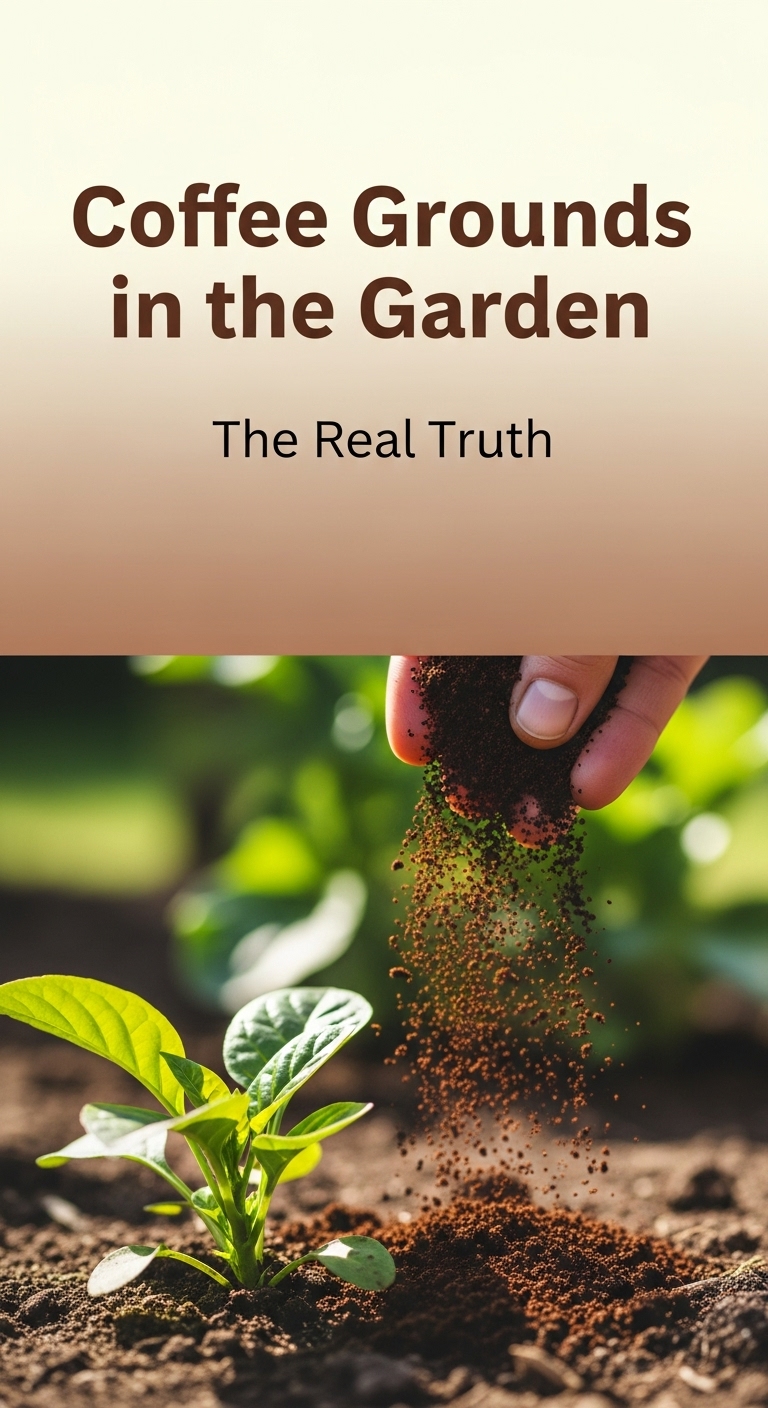As an Amazon Associate CoffeeXplore.com earns from qualifying purchases.
Coffee Grounds in the Garden: The Real Truth
Ever wondered if that daily coffee habit could be your garden’s best-kept secret? The answer is more complex and interesting than you think. For years, gardeners have debated whether using coffee grounds is a miracle tips or a harmful myth, with conflicting advice creating confusion. This guide cuts through the noise to give you the real truth.
Yes, used coffee grounds are beneficial for gardens due to their nutrient content and ability to improve soil structure, but they must be applied correctly to avoid potential drawbacks like mold or stunting young plants. Leveraging extensive analysis of data from horticultural experts and university extension services, this guide unpacks the scientifically-backed benefits, the safest application methods, and the critical precautions to help you effectively turn your coffee waste into a garden asset.
Key Facts
- Rich in Nutrients: Used coffee grounds provide a slow-release source of essential plant nutrients, including nitrogen, phosphorus, potassium, magnesium, and calcium, which are vital for healthy growth.
- Myth-Busting pH: Contrary to a widespread myth, used coffee grounds are not highly acidic. The brewing process neutralizes most of the acid, leaving them with a near-neutral pH between 6.5 and 6.8, as confirmed by sources like Oregon State University Extension.
- Composting is Safest: The number one recommended method for using coffee grounds is in a compost pile. To maintain a healthy balance, they should constitute no more than 15-25% of the total compost volume, a guideline supported by experts like the Travis County Master Gardeners.
- Direct Application Risk: Applying a thick, unmixed layer of coffee grounds directly to the soil surface can cause them to compact and dry into a water-repellent crust, blocking moisture and air from reaching plant roots.
- Natural Pest Deterrent: While not a foolproof solution, many gardeners report that the gritty texture and scent of coffee grounds help deter soft-bodied pests like slugs and snails.
The Science of the Grind: 6 Key Benefits of Using Coffee Grounds
The answer to are used coffee grounds good for gardens is a resounding yes, but the real power lies in understanding the science behind why they work. These grounds are far more than just waste; they are a powerhouse of organic matter and nutrients that can transform your soil’s health from the ground up. Before you learn how to use them, let’s explore the six key benefits that make them a valuable addition to your sustainable gardening toolkit.

- A Rich Source of Plant Nutrients
Used coffee grounds are packed with essential nutrients that plants crave. They contain a significant amount of nitrogen, which is crucial for lush, green foliage, as well as phosphorus and potassium. Furthermore, they supply vital micronutrients like magnesium, calcium, copper, and iron, all of which contribute to a plant’s overall health and vitality. -
Improves Soil Structure and Health
Perhaps the most significant benefit of using coffee grounds in the garden is their ability to improve soil structure. As a fine-textured organic material, they help break up heavy clay soils, improving drainage and aeration. In sandy soils, they do the opposite, helping to retain moisture and nutrients that would otherwise wash away. This improvement in soil tilth creates a better environment for root growth. -
A Powerful Compost Booster
Adding used coffee grounds to your compost pile is one of the best ways to harness their power. Classified as a “green” material due to their high nitrogen content, they provide the fuel that microorganisms need to break down “brown” (carbon-rich) materials like dried leaves and twigs. This helps heat up the pile, accelerating the decomposition process and creating nutrient-rich compost faster. -
Attracts Earthworms
Did you know? Earthworms, the gardener’s best friend, are actively drawn to coffee grounds, which they consume as a food source. As these beneficial creatures tunnel through your soil, they create channels that improve aeration and water penetration. Their castings (waste) are one of the richest natural fertilizers available, further enriching your garden soil at a microbial level. -
Deters Common Garden Pests
While not a chemical pesticide, coffee grounds can serve as a physical and scent-based deterrent for several common garden pests. The abrasive texture is unappealing to soft-bodied pests like slugs and snails, creating a barrier they are reluctant to cross. Many gardeners also report that the strong scent helps discourage cats from using garden beds as a litter box and may even ward off ants. -
Suppresses Fungal Diseases
Emerging research suggests that the beneficial bacteria and fungi that thrive on decomposing coffee grounds can help outcompete and suppress harmful plant pathogens. By fostering a healthy soil food web, you create an environment where diseases like certain types of rot and wilt find it harder to take hold, giving your plants a natural defense boost.
Benefit Breakdown: Nutrients & Soil Structure
The two headline benefits—nutrients and soil improvement—are what make used coffee grounds so good for gardens. Think of coffee grounds not as a quick energy shot for your plants, but as a slow, steady, and healthy meal that improves the soil’s long-term health. The nitrogen they contain isn’t immediately available; instead, it’s released slowly over time as soil microbes break down the organic matter. This “slow-release” process, a key point noted by sources like The Old Farmer’s Almanac, prevents the sudden, weak growth that can come from synthetic fertilizers and provides sustained nourishment.
Simultaneously, the physical properties of the grounds get to work on your soil’s texture.
- Key Nutrients Provided: Nitrogen (N), Phosphorus (P), Potassium (K), Calcium (Ca), Magnesium (Mg), Iron (Fe), Copper (Cu), Zinc (Zn).
- How They Improve Soil:
- Enhances Drainage: Loosens compacted, heavy clay soil, allowing water to drain more freely.
- Increases Water Retention: Helps sandy soil hold onto moisture and nutrients near plant roots.
- Improves Aeration: The fine particles create tiny air pockets, delivering oxygen to plant roots.
- Prevents Compaction: Regular additions of organic matter like coffee grounds keep soil light and friable.
How to Use Coffee Grounds Correctly: 4 Safe & Effective Methods
Knowing that are used coffee grounds good for gardens is only half the battle. Applying them incorrectly can negate their benefits and even cause problems. To ensure success, it’s crucial to use one of the following proven methods. Based on a consensus from multiple authoritative sources like The Spruce and Garden Design, composting is the #1 recommended method for its safety and effectiveness.
Pro Tip: Always let your used coffee grounds cool completely before adding them to your compost pile or garden to protect beneficial microbes.
- Composting (The Gold Standard)
- Direct Soil Amendment (With Caution)
- Liquid “Coffee Tea” Fertilizer
- As a Mixed Mulch Component
Method 1: The Gold Standard – Composting Coffee Grounds
Composting is by far the safest and most effective way to incorporate coffee grounds into your garden. The composting process neutralizes any remaining caffeine that could inhibit plant growth and fully integrates the nutrients into a stable, balanced soil amendment.
- Balance Your Browns: Coffee grounds are a nitrogen-rich “green” material. To create healthy compost, you must balance them with carbon-rich “brown” materials. For every part of coffee grounds you add, mix in two to three parts of materials like dried leaves, shredded cardboard, straw, or wood chips.
- Mind the Ratio: While excellent for compost, grounds shouldn’t dominate the pile. Aim for coffee grounds to make up no more than 15-25% of your total compost volume. This specific ratio, recommended by the Travis County Master Gardeners, ensures the pile doesn’t become too dense or acidic.
- Include the Filter: Don’t worry about separating the grounds from their filter. Unbleached paper coffee filters are a carbon-based material and can be thrown right into the compost pile along with the grounds.
Method 2: Applying Directly to Soil (With Caution)
You can sprinkle coffee grounds directly onto your garden beds, but this method requires care. The biggest risk, highlighted by multiple horticultural sources, is that a thick layer of grounds can dry into a dense, water-repellent crust that suffocates roots and sheds water instead of absorbing it.
| Guideline | Why It’s Important |
|---|---|
| Apply a thin layer (1/2 inch max) | Prevents the formation of a hard, water-repellent crust that blocks moisture. |
| Rake into top 1-2 inches of soil | Ensures proper water and air penetration and helps microbes begin decomposition. |
| Keep away from plant stems | Avoids direct contact that could lead to mold growth or potential “burning” of tender stems. |
The Plant Compatibility List: Which Plants Love Coffee Grounds (and Which Don’t)
One of the most persistent questions gardeners have is about which specific plants benefit from coffee grounds. The answer is tied to a common misunderstanding about acidity.
Myth Debunked: Contrary to popular belief, used coffee grounds are nearly pH neutral (6.5-6.8). They won’t significantly acidify your soil. The brewing process leaches the vast majority of the acid into your coffee cup. While fresh, unbrewed grounds are acidic, the used grounds you have left over are safe for most plants.
The primary benefit for all plants comes from the slow-release nitrogen and improved soil structure. Based on this list, which plants in your garden are the best candidates for a coffee ground treat?

Plants That Benefit
These plants are either heavy nitrogen feeders or appreciate the improved soil structure that coffee grounds provide.
- Leafy Greens: Spinach, lettuce, kale, and other greens thrive on the steady supply of nitrogen.
- Nightshades: Tomatoes, peppers, and cucumbers benefit greatly from the rich organic matter.
- Cruciferous Vegetables: Broccoli, cauliflower, and Brussels sprouts use the nutrients for robust growth.
- Roses: These classic flowers are known to be heavy feeders and respond well to the nutrients in composted grounds.
- Root Vegetables: Carrots and radishes appreciate the looser soil structure, which allows them to grow straight and large.
- Acid-Loving Plants: While not acidifying the soil much, plants like hydrangeas, blueberries, azaleas, and rhododendrons still love the boost of organic matter and nutrients.
Plants to Be Cautious With
These plants either prefer alkaline soil or have specific sensitivities that make coffee grounds a poor choice, especially when applied directly.
- Young Seedlings: The residual caffeine, though minimal, can have an allelopathic effect, meaning it can inhibit seed germination and stunt the growth of very young, delicate plants. Always use fully finished compost for seedlings.
- Alkaline-Loving Plants: Plants that prefer “sweet” or alkaline soil, such as lavender, rosemary, and geraniums, may not appreciate the addition.
- Succulents and Cacti: These plants require dry, well-draining soil, and the moisture-retentive properties of coffee grounds can potentially lead to root rot.
Potential Risks & Precautions: A Gardener’s Checklist
To be a responsible gardener, it’s just as important to know the potential disadvantages of coffee grounds as it is to know the benefits. By being aware of these risks, you can easily avoid them. This checklist frames our expert advice, enhancing trustworthiness and ensuring your gardening efforts are successful.
When in doubt, compost it out! Composting is the safest way to mitigate almost all potential risks associated with coffee grounds.
- Moderation is Key: Over-application is the most common mistake. Applying too many grounds directly to the soil can lead to excessive nitrogen, which can stunt plant growth, or create the dreaded water-repellent crust.
- Beware of Mold: Wet coffee grounds applied in a thick layer can quickly develop mold. To prevent this, either dry your grounds before direct application or, better yet, add them to an aerated compost pile.
- Protect Young Plants: As mentioned, the residual caffeine can inhibit the germination of seeds and the growth of seedlings. Avoid using fresh grounds in areas where you are starting seeds or have very young transplants.
- Pet Safety: Caffeine is toxic to dogs and cats in large quantities. While used grounds have very low levels, a pet that eats a large amount of grounds could still become ill. To be safe, always work the grounds into your soil or compost pile where pets can’t easily access and ingest them.
To make your composting journey even easier, consider getting a dedicated compost bin and aeration tool.
FAQs About Using Coffee Grounds in the Garden
Even with all this information, you might still have a few specific questions. Here are direct answers to some of the most common queries gardeners have about using coffee grounds.
Which plants specifically do not like used coffee grounds?
Plants that prefer alkaline or drier soil conditions are the primary ones to be cautious with. This is less about the pH and more about the soil texture and moisture retention.
* Lavender
* Rosemary
* Geraniums
* Succulents and Cacti
These plants thrive in gritty, fast-draining soil, and the fine, moisture-retentive texture of coffee grounds can be detrimental to their root health.
Can I put used coffee grounds directly on top of my garden soil?
Yes, but only in a thin layer (no more than 1/2 inch) that is then raked into the top 1-2 inches of soil to prevent it from drying into a water-repellent crust. This advice, echoed by sources like Oregon State University Extension and PlantVillage, is critical. Simply sprinkling them on top is a common mistake that can do more harm than good by blocking water and air.
Do used coffee grounds really make soil more acidic?
No, this is a common myth. The brewing process leaches out most of the acid, leaving used coffee grounds with a near-neutral pH of 6.5 to 6.8. While fresh, unbrewed coffee grounds are acidic, the waste product from your coffee maker will not significantly alter your soil’s acidity, making them safe for a wide variety of plants beyond just the “acid-lovers.”
What animals will coffee grounds keep away from my garden?
Many gardeners report that the gritty texture and scent of coffee grounds can help deter pests like slugs, snails, and ants. Some also use it to discourage cats from using garden beds as a litter box. The effectiveness can vary, but it’s a safe, organic method to try. The abrasive nature of the grounds is irritating to the soft bodies of slugs and snails, creating a barrier they are hesitant to cross.
Are coffee grounds safe for my dog if used in the garden?
While used grounds have low caffeine, it can be toxic to dogs if ingested in large amounts. To be safe, it’s best to mix grounds into the soil or a compost pile where pets can’t easily eat them. A curious dog that consumes a large quantity of concentrated grounds could experience caffeine toxicity. The safest practice for pet owners is to ensure the grounds are not left in accessible clumps on the soil surface.
Final Summary: Turn Your Coffee Waste into a Garden Asset
The debate is over: are used coffee grounds good for gardens? The answer is a clear and confident “yes,” provided you use them intelligently. By moving beyond the myths and understanding the simple science, you can transform a daily waste product into one of your garden’s most valuable free resources. It’s a perfect example of sustainable, closed-loop gardening that benefits your plants, your soil, and the planet.
Remember these three key takeaways to ensure your success:
- The Benefit: Coffee grounds are a fantastic source of slow-release nitrogen and organic matter that improves soil structure, feeds plants, and encourages beneficial earthworms.
- The How-To: Composting is the gold standard. If applying directly, always use a thin layer and rake it into the top few inches of soil to avoid creating a water-blocking crust.
- The Caution: Moderation is crucial. Avoid using grounds on young seedlings, and for pet owners, always incorporate them into the soil or compost to prevent ingestion.
Now you have the real truth. Go ahead and confidently give your garden its next coffee fix—the right way
Last update on 2025-12-15 / Affiliate links / Images from Amazon Product Advertising API

